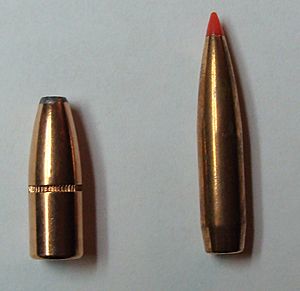Ballistic coefficient facts for kids
In ballistics, the ballistic coefficient (BC) of a bullet is a measure of its power to be stronger than air resistance in flight. A high BC means the bullet will slow down less. It will have more of its speed left when it reaches the target. BC depends on mass, diameter, and drag coefficient. Ballistic coefficients have units of pounds per square inch (lb/in²) or kilograms per square meter (kg/m²). BCs for bullets are normally stated in lb/in² by their manufacturers. It is so common that the measurements don't usually say lb/in². The values for BC can be as low as 0.12 and as high as 1.00 for commonly used bullets.
Contents
Bullet performance
A bullet with a high BC will travel farther than one with a low BC since it will keep its speed better, resist the wind better, and “shoot flatter” (see external ballistics).
When hunting with a rifle, a higher BC is good for several reasons. A higher BC results in a flatter flight. This makes the shooter less likely to miss the target because of the bullet dropping during flight. The shooter does not have to try to guess his distance from the game animal and then guess how much the bullet will drop before it hits the target area on the animal.
This difference in flight path becomes more important at longer distances. Sometimes, the difference between a bullet with a high BC and a low BC can result in a space of 1 foot (30 cm) at 550 yards (550 meters). A bullet with a high BC arrives at the target faster and with more energy than one with a low BC. Since the higher BC bullet gets to the target more quickly, it is also less affected by crosswinds (wind blowing in a different direction than the bullet travels).
General trends
Sporting bullets have BCs in the range of 0.12 to slightly over 1.00. The higher the number, the more aerodynamic the bullet is. Very-low-drag bullets with BCs ≥ 1.10 can be designed and made on special lathes. These special bullets often must
Bullet makers often offer several weights and types for a given size. Heavy-for-caliber pointed (spitzer) bullets with a boat tail design have high BCs. Lighter bullets with square tails and rounded or flat noses have lower BCs.
In the United States, hunting cartridges such as the .25-06 Remington (a 6.35 mm caliber), the .270 Winchester (a 6.8 mm caliber), and the .284 Winchester (a 7 mm caliber) are used when the hunter wants a bullet with a high BC. In the larger sizes, the .338 Lapua Magnum and the .50 BMG are popular with very high BC bullets for shooting beyond 1000 meters. They have very high BCs. Other choices in the larger size are the .375 and .408 Cheyenne Tactical and the .416 Barrett.
Changes in bullet ballistic coefficients
Differences in air density in areas where the bullets are fired can affect the measurements. Therefore, Ballistic coefficients are not exact measurements; they are averages.
To find the correct BC (some scientists would call it drag coefficients), Doppler radar-measurements are required. The average person does not have this equipment. Weibel 1000e Doppler radars are used by governments, professional ballisticians, defense forces, and a few ammunition manufacturers to get exact real-world data on the flight behavior of bullets of interest.
Like any experiment, bullets are fired several times and measurements are taken and averaged. The results are then listed as that bullet's BC.
Related pages
- External ballistics - The behavior of a projectile in flight.
- Trajectory of a projectile - Ballistic coefficient can be used to calculate the path of a projectile. The above page lacks any practical application of BC. BC is an easy way to account for air resistance.
Freeware small arms ballistic coefficient calculators
There are free computer programs that can be used to calculate ballistic coefficients if other information is known.
Images for kids
See also
 In Spanish: Coeficiente balístico para niños
In Spanish: Coeficiente balístico para niños




